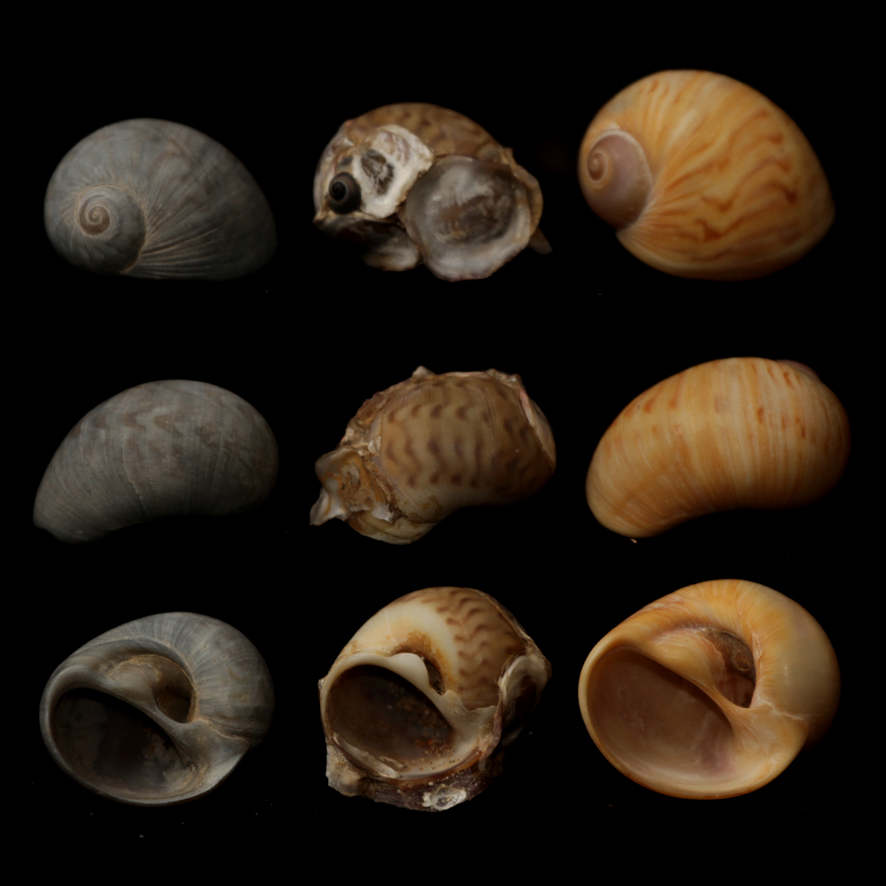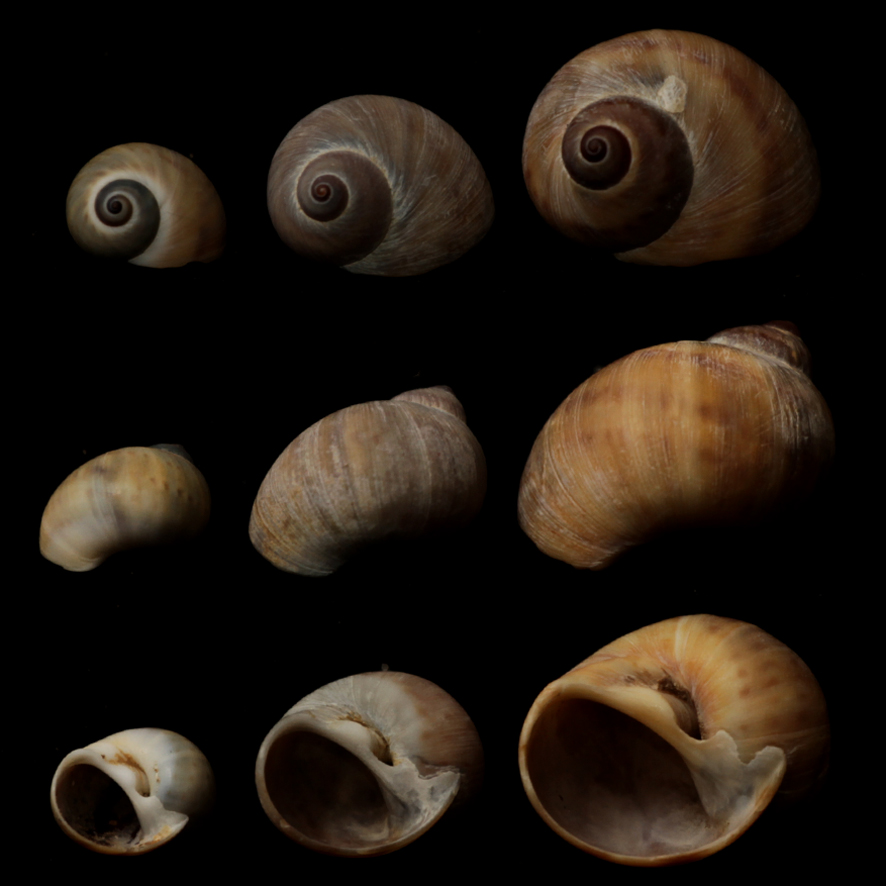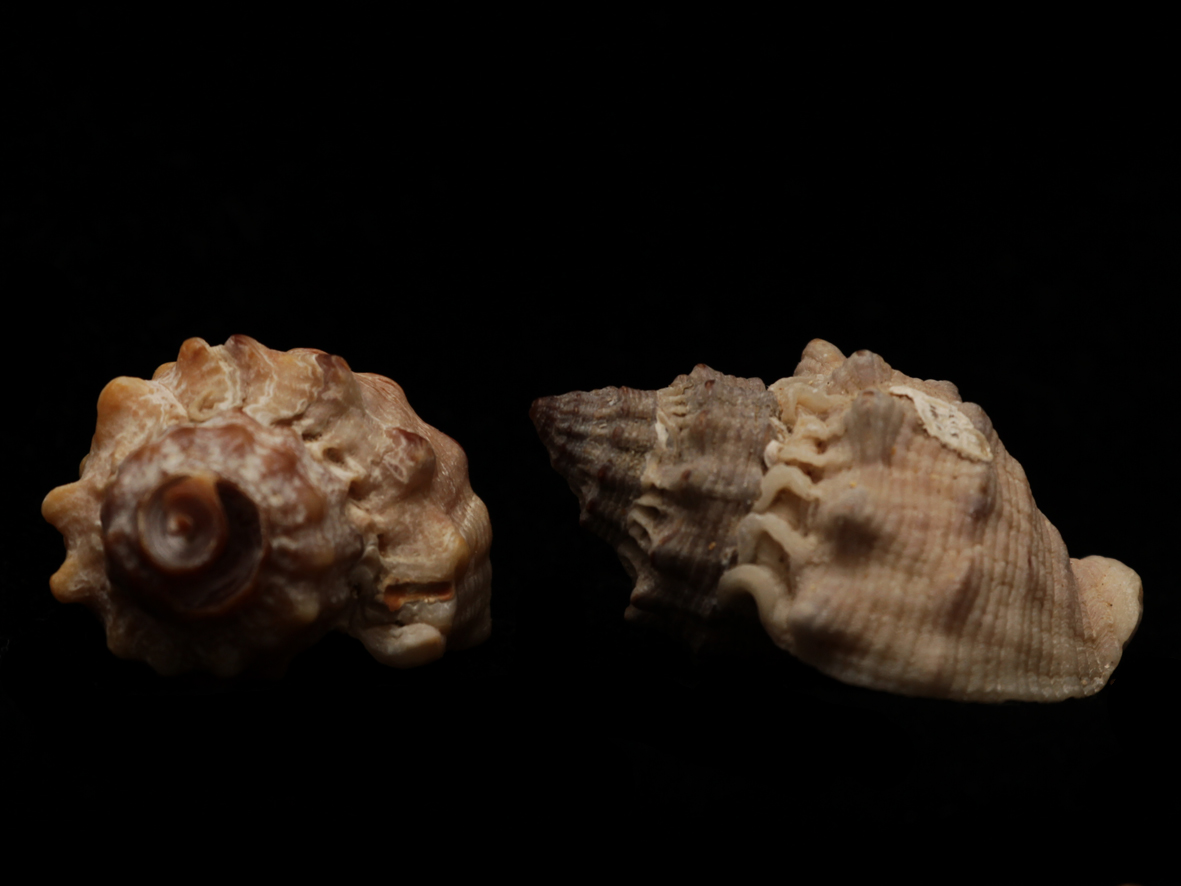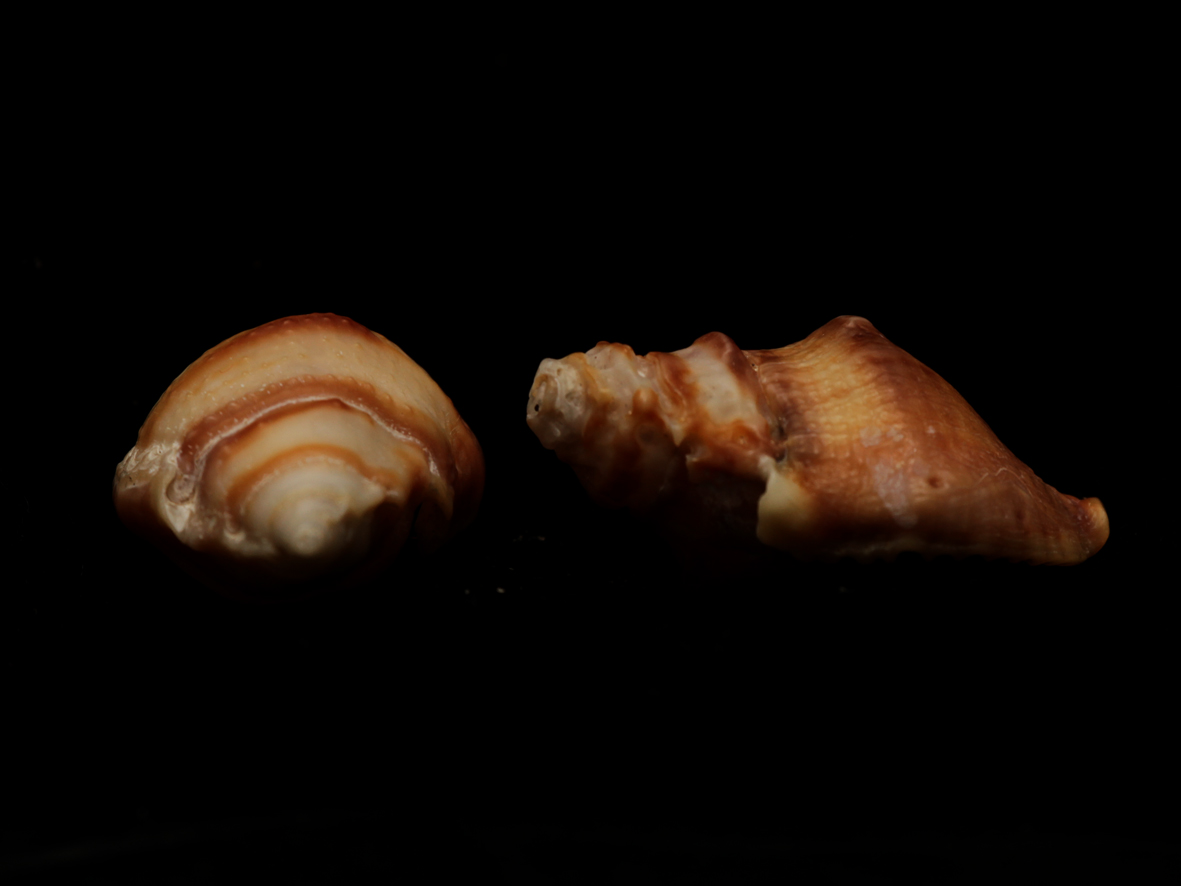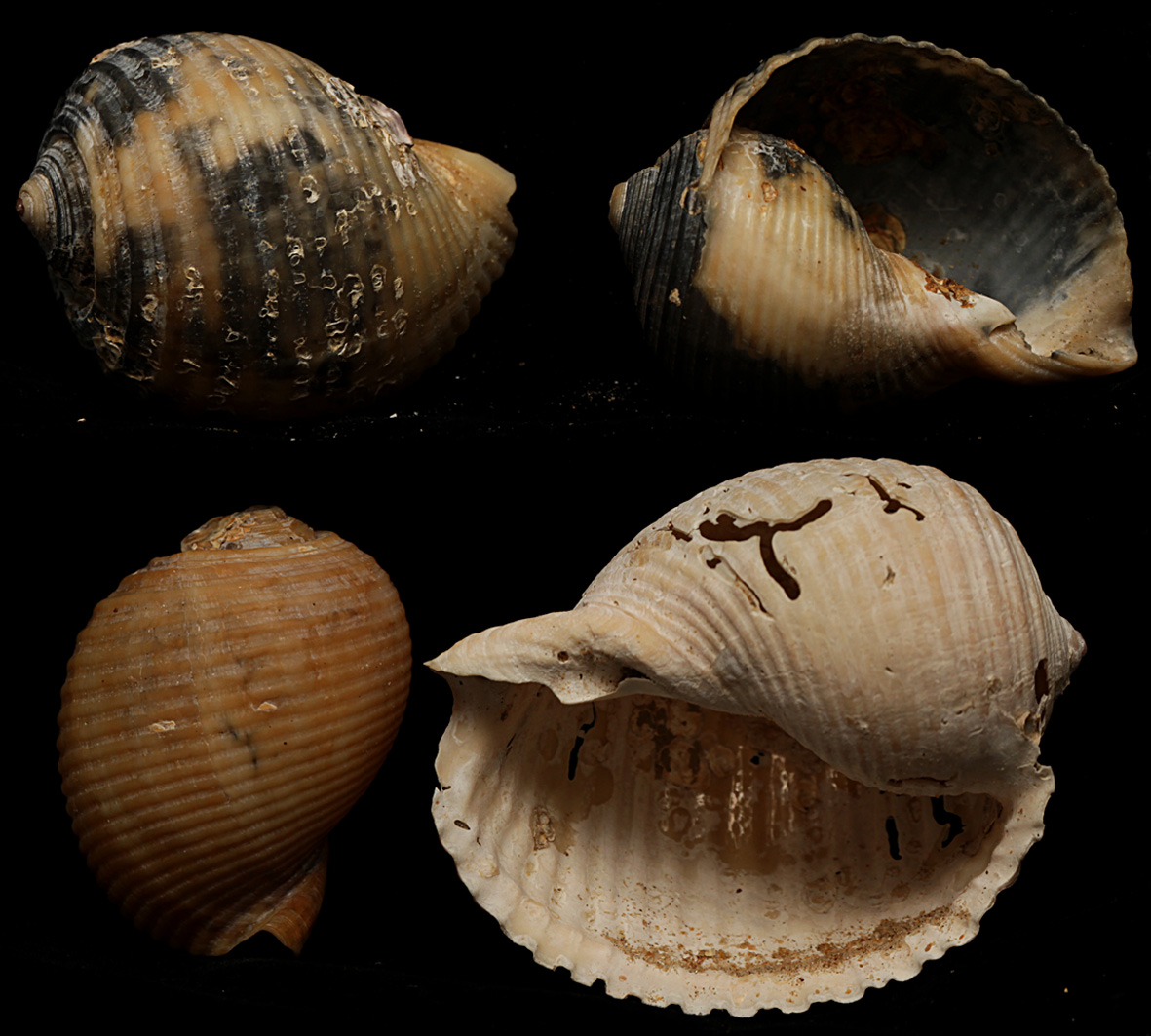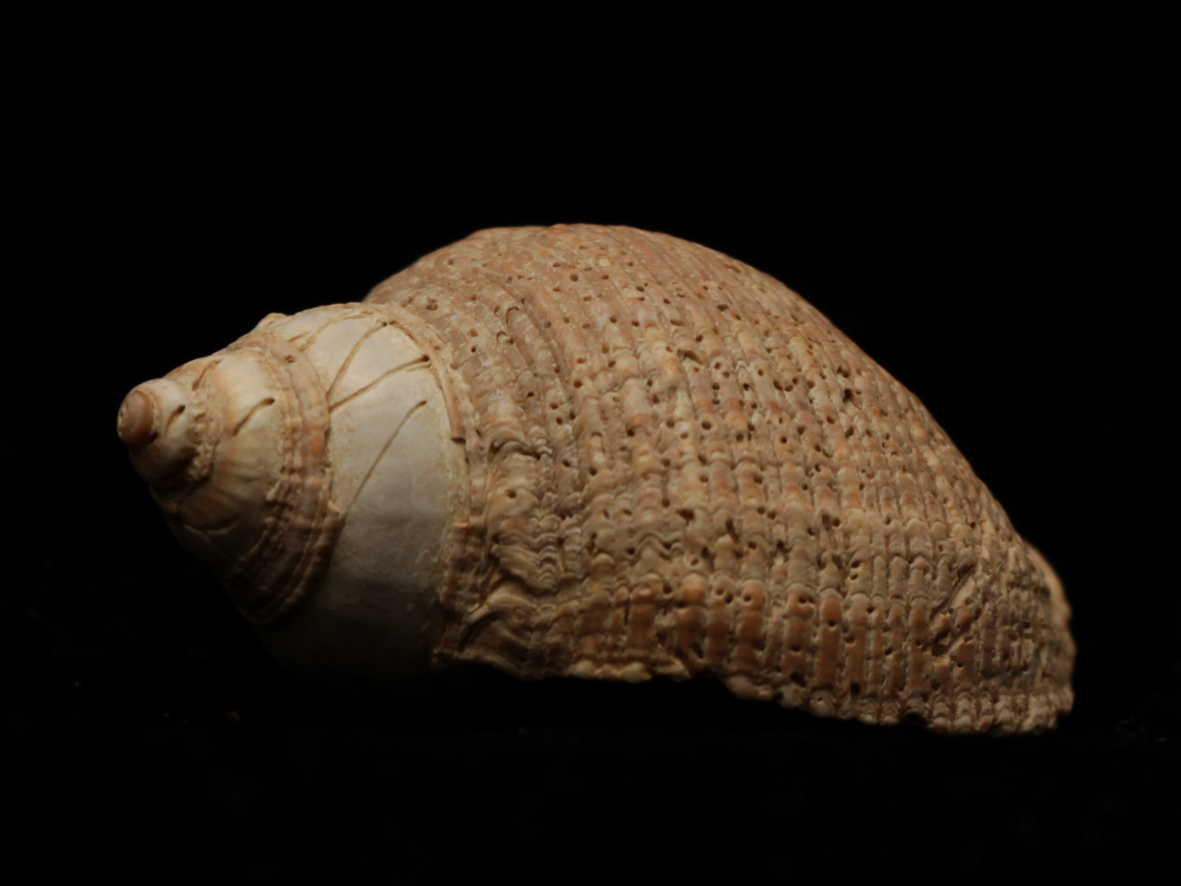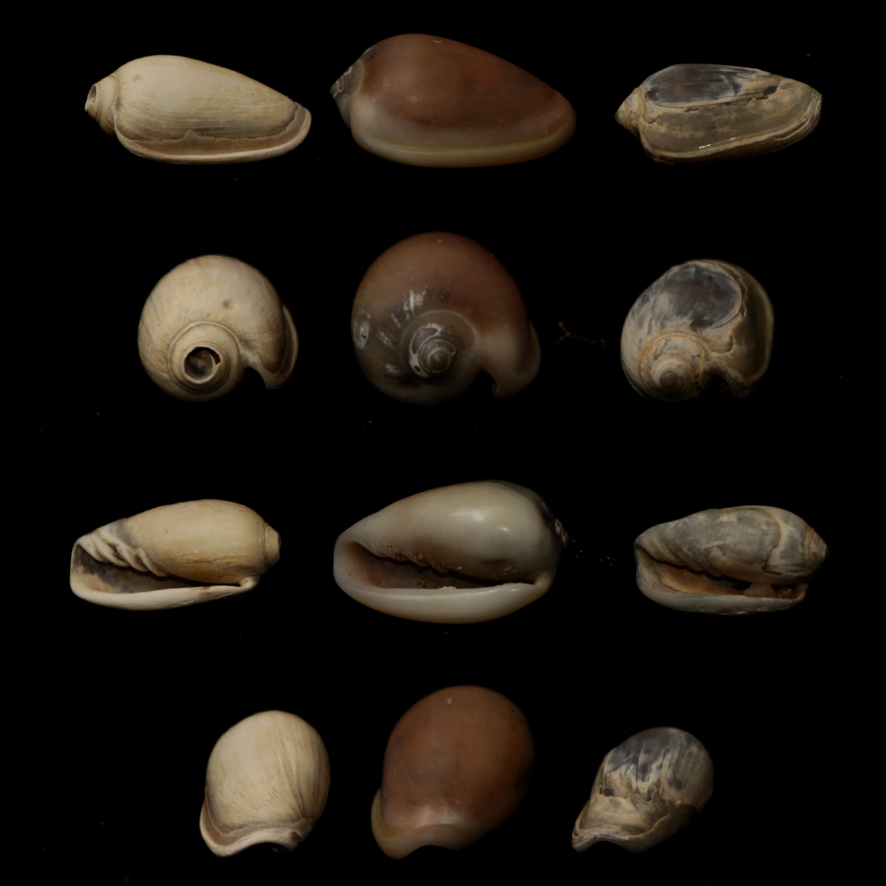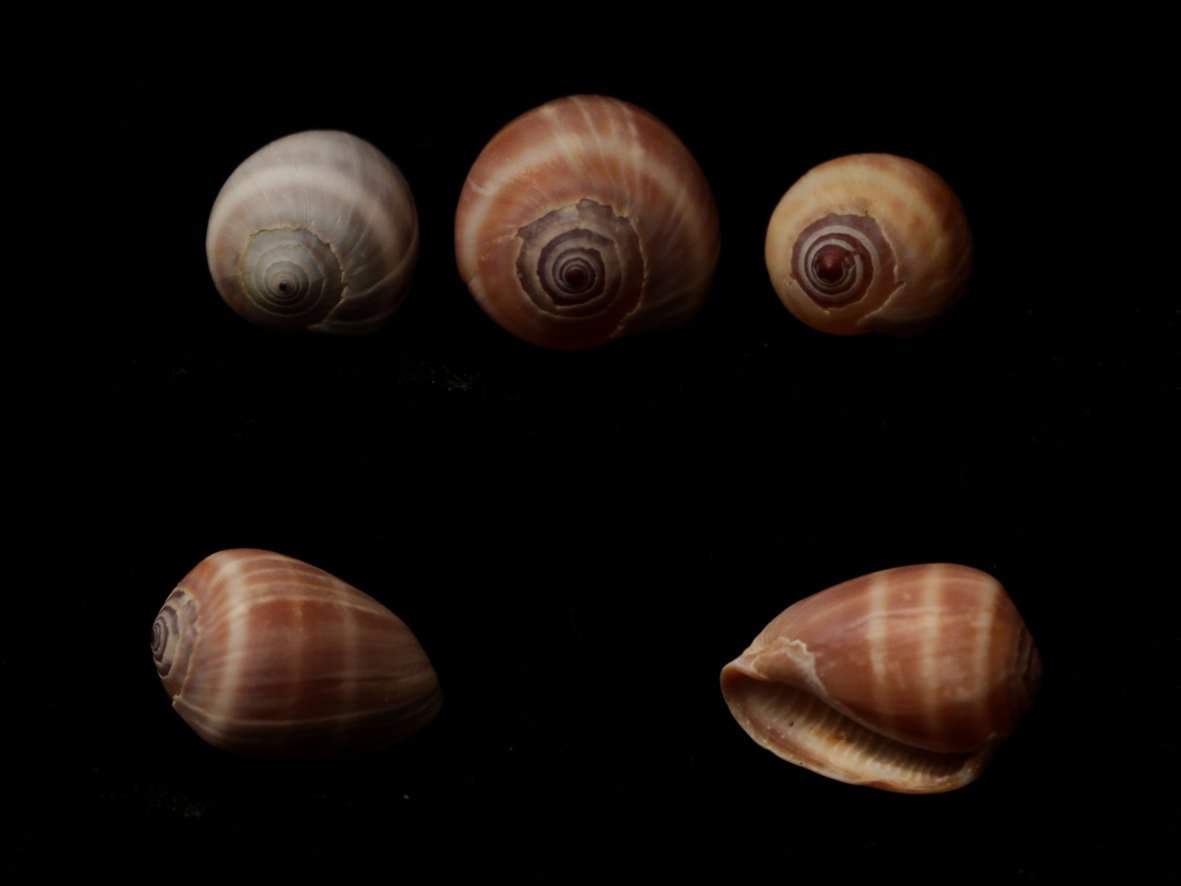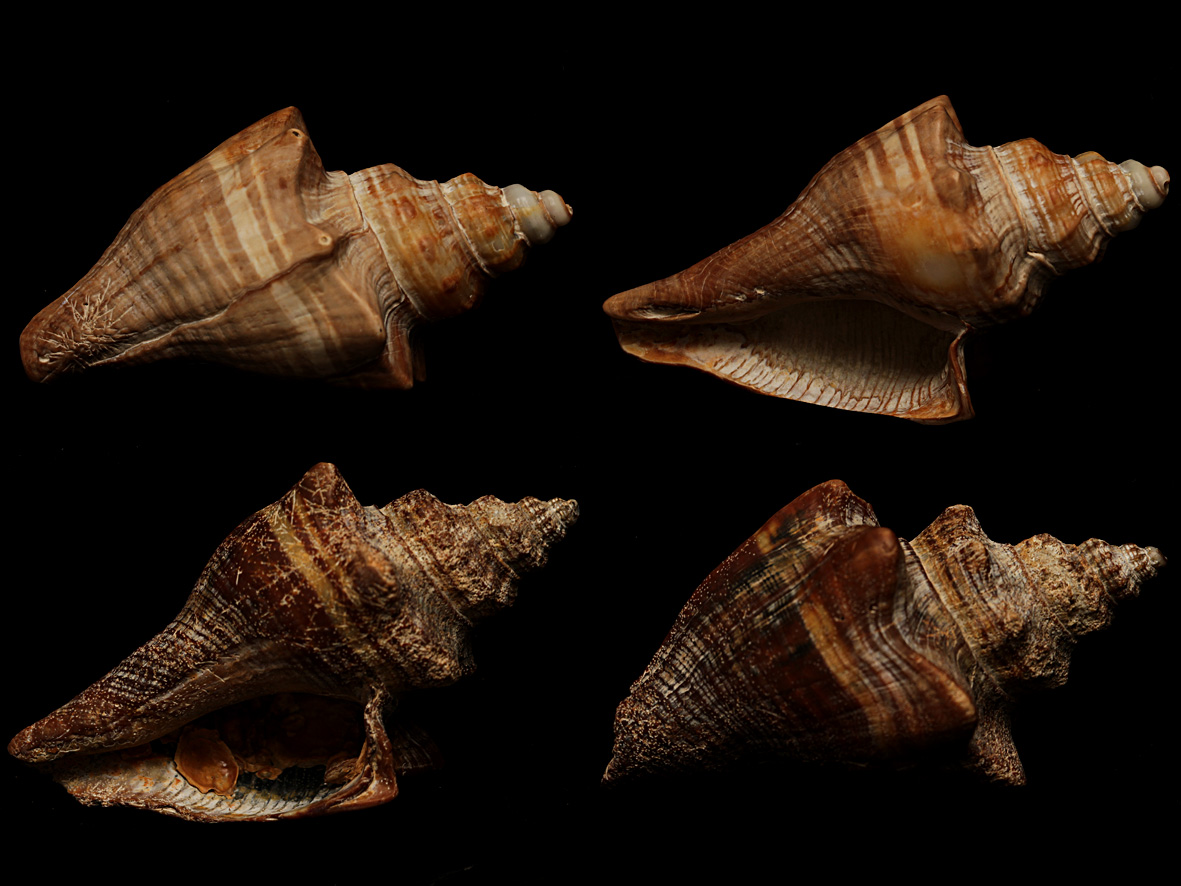Gastropods
The Gastropoda or Gastropods is a class that includes snails and slugs. They are by far the largest groups of molluscs, with more than 62,000 described living species, and they comprise about 80% of living molluscs. Animals in this class are characterized by a single coiled shell containing the coiled visceral mass and a head-foot bearing sensory tentacles, eyes, and a radula for feeding. Most gastropods live attached to hard surfaces such as rocks, jetties, harbor walls, and roots of trees, or wander over the surface of the sand or mud. (About.com, 2014).
Natica cayennensis (Recluz, 1850) – Cayenne Natica
The Natica cayennensis is similar to that of the Natica marochiensis shell, but is slightly bigger (perhaps up to ¾ cm). It is also duller, less colorful (as in it looks faded) and not so polished when compared to the Natica marochiensis shell. The background color is a creamy yellow with three spiral rows of light brown markings; older more worn out specimens are often grey. There are five whorls, as well as a large body whorl, but the apex is much flatter than in Natica marochiensis and it is the same color as the rest of the shell. The umbilicus is large and the callus and base of the shell are white or yellow-cream. The interior of the shell is usually white or white-brown, often tinted with purple. The surface is rougher than in Natica marochiensis due to growth wrinkles, which become especially prominent near the suture line. The white suture line of Natica marochiensis is absent. The Natica cayennensis is not as common as Natica marochiensis.
Natica marochiensis (Gmelin, 1791) - Morocco Natica
Reaching up to 2.5 cm long, the Natica marochiensis has a strong shell that has a yellow-brown exterior, turning black or dark red at the apex, with 5 spiral rows of brown markings. On the shell there are five whorls, the body whorl being fairly large. The umbilicus is small, but the callus is fairly large and white in color, as is the suture line and the base of the shell. The interior of the shell is smooth and brownish. This shell is fairly common.
Thais haemastoma floridana (Conrad, 1837) - Florida Rock or Dye Shell
Measuring at up to 9 cm in length, the Thais haemastoma is fairly heavy and is often rough in texture. Its spire is sharp and fairly well developed, but is less than ½ the body whorl in length. There are six whorls, but the suture line between them may sometimes be indistinct. The color of the shell varies tremendously from cream, yellow, grey, orange, orange-brown, red-brown, brown, black, and is often banded or blotched with purple and in some specimens’ brown and black as well. Sculptures also varies considerably but always consists of numerous, fine spiral striae and axial growth markings.
Bursa spadicea (Montfort, 1810) – Chestnut frog shell
The Bursa spadicea measures up to 5 cm long. It is thick, heavy, and strong with a well-developed and pointed spire, the laterally flattened. Its color usually consists of alternating spiral bands of chestnut brown and white, but often grey/black, lavender or yellow/orange may be present instead. A row of varies occurs up each edge of the flattened spire. The surface is covered by spiral rows of small beads. These gastropods live in fairly deep water and thus the specimens that wash up on the beach have somewhat faded colors and the beads are usually indistinct. The shell has six whorls and the body whorl fairly well developed with a slightly elongated aperture. Columella bears about 18 strong plicae all along its length. The interior of aperture is lightly furrowed and is white in color often tinted with lavender. It has prominent siphonal and anal canals. This shell was once fairly common.
Tonna galea (Linnaeus, 1758)- Florida Cask Shell
The Tonna galea usually grows up to 25 cm. Its color varies from a uniform white or a creamy yellow with slate grey blotches to a uniform slate grey. The shell is nearly as wide as it is long, due to a very large body whorl that forms almost 90% of the shell. In large specimens, this shell is fairly strong but is thinner and often broken into smaller ones. There are six whorls that make up this shell, and the spiral suture between them is deeply sunken, the columella is twisted. There are about twenty smooth broad ribs running spirally, separated by fairly deep grooves. The outer lip is slightly thickened at its edge and is crenulated.
Anachis sparta
There are two other species of Anachis, as yet unidentified, found here. They both closely resemble A. Obesa even possessing the spiral cord. In one of the species however the columella base and siphonal canal twist, or turn back, more than in A. Obesa. These species are not uncommon.
Nassarius vibex (Say, 1822)
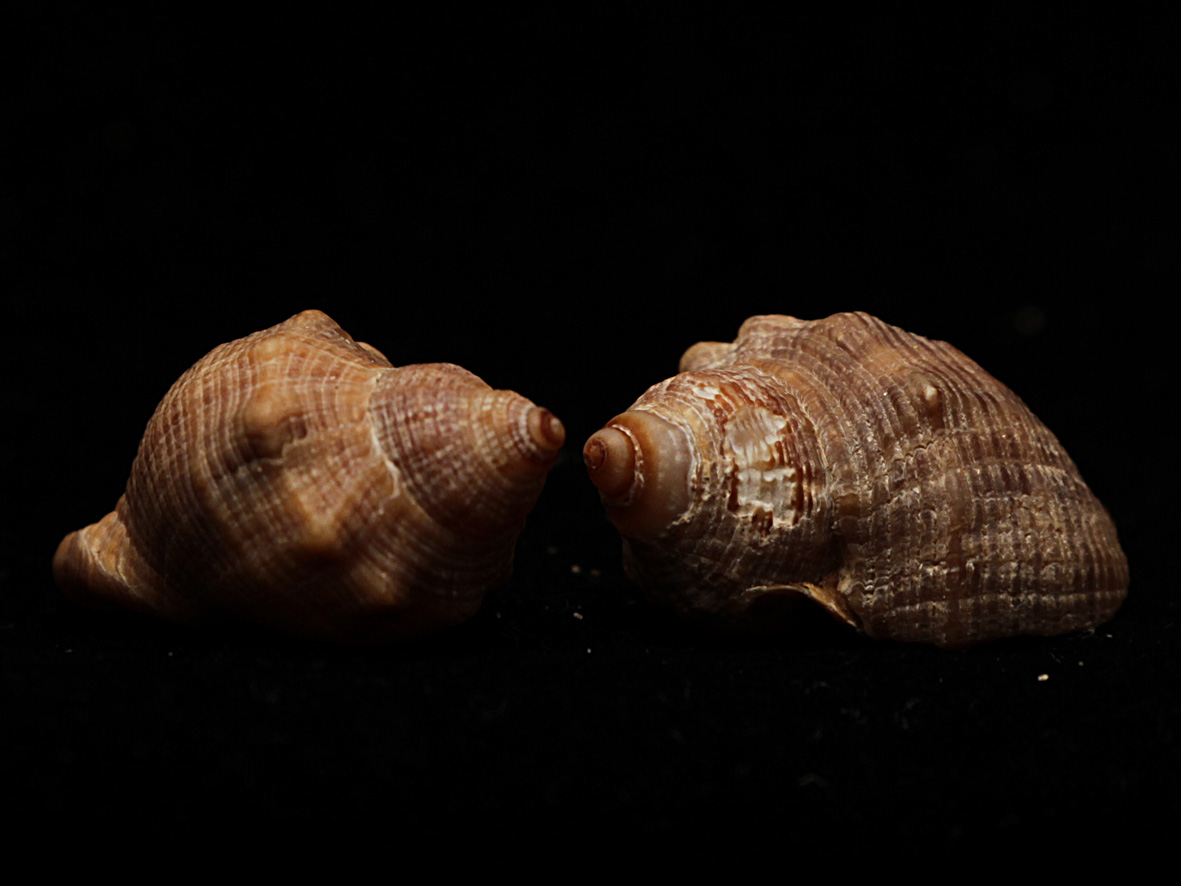
The Nassarius Vibex is usually a whitish brown color, although some found may be black. The aperture is usually ear-shaped, and the sculpture consists of 11-13 strong, beaded axial ribs and numerous fine spiral threads. There are about 7 whorls on the shell and the suture between them is ridged and beaded, it is also noted that there is a well-developed parietal shield.
Marginella prunum Gmelin
The Marginella prunum measures up to 2.5 cm in length and is known to be rather strong. It has a pinkish-grey or grey-black color; older more worn specimens are often rose pink and bear chalky white lines, which are the different shell layers. Its spire is moderately well developed and pointed, and its thickened untoothed outer lip is burred over along its outer edge. The columella bears 4 plicae. This shell is very common.
Melampus coffea (Linneaus, 1758) - Coffee Bean Shell
Measuring up to nearly 2 cm long, the Melampus coffea is fairly sturdy, and smooth. Its exterior color is pale chocolate with 3 narrow creamy bands on the body whorl. Many specimens found on the beach are faded, and are often chalky white in color. The shell has four or five whorls, the body whorl being very large and the spire short and flattened. The outer lip, although not thick, is crenulated due to the termination of many fine internal ribs. The columella bears two white plicae. It is usually found in the mudflats, coastal marshes, and mangrove swamps, but empty shells were often found along the beach as well. The smallest specimen found on Braamspunt is less than 0.5 cm long.
Pugilina morio Lamarck
The Pugilina morio shell measures up to 15 cm long and 7.5 cm wide. It has a rather high count of whorls and terminates in a sharp point. Its color is usually a chocolate-brown and near the top of each whorl there is a slightly sunken yellow-cream spiral band. In some specimens this band was discolored and indistinct. At the top of each whorl, there are a number of large, prominent hollow horns that gradually get smaller and more solid towards the apex. The sculpturing consists of numerous fine spiral striae, which become grouped and more prominent at certain intervals to form ribs. In addition there are numerous, very fine axial striae and growth marks. The body whorl is very large and has a long narrow aperture. The outer lip is only slightly thickened and is crenulated due to spirally arranged internal ribs. There is a thick brown velvety periostracum and specimens washed up on the beach without it are often highly polished.
Cymatium poulseni (Morch, 1877) - Poulsen’s Triton
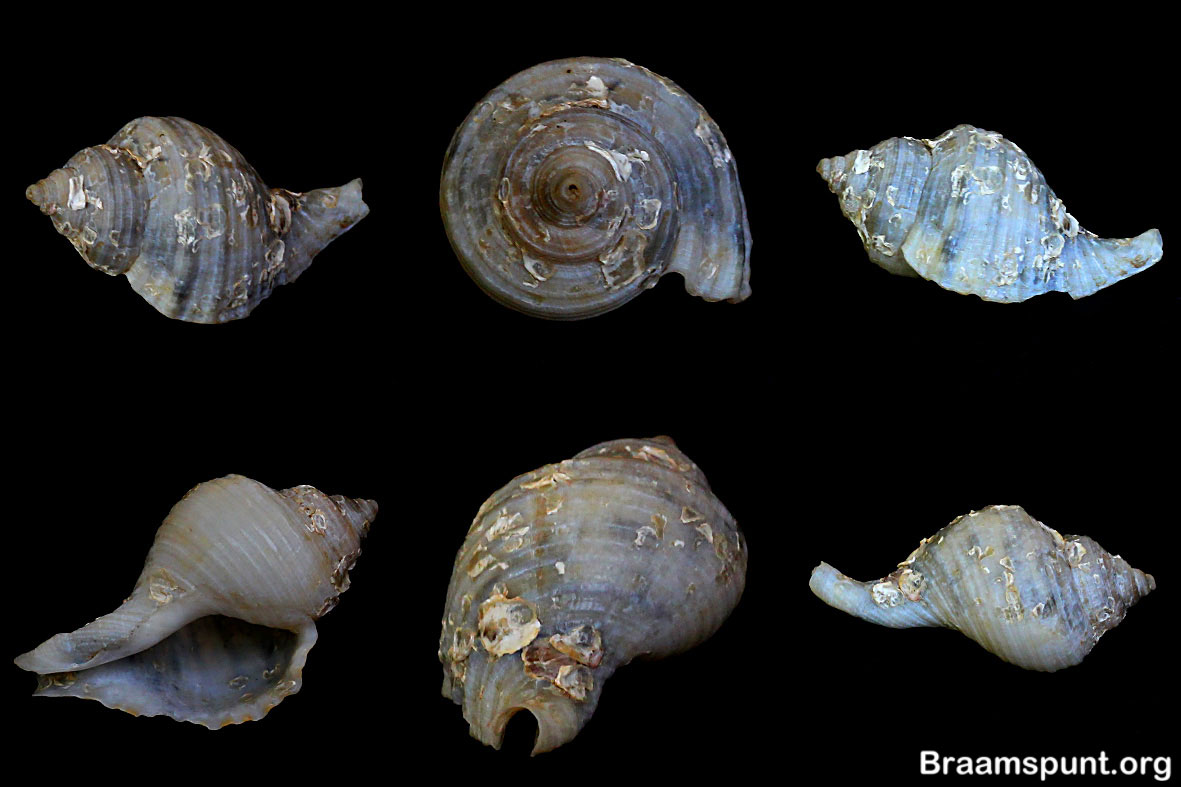 Up to 7.5 cm in length, fairly thick, strong, but light and slightly glazed. Spire not extremey well developed (less than ½ of total length) blunt, and with the nuclear whorls often missing. 5 or 6 whorls with a well-defined but unsunken suture line. Yellowish-brown or light grey in color. Sculpture consists of smooth spiral ribs and fine axial growth lines. There are about 20 of these ribs on the body whorl, but this species is not as heavily scultured as some of the other tritons. Body whorl fairly well developed (over ½ total length) with a fairly large, slightly elongate D-shaped aperture. Outer lip thickened and crenulated along its inner edge. Columella not plicate. Interior of aperture lighter than the external color and crenulated. Siphonal canal fairly well developed.
Up to 7.5 cm in length, fairly thick, strong, but light and slightly glazed. Spire not extremey well developed (less than ½ of total length) blunt, and with the nuclear whorls often missing. 5 or 6 whorls with a well-defined but unsunken suture line. Yellowish-brown or light grey in color. Sculpture consists of smooth spiral ribs and fine axial growth lines. There are about 20 of these ribs on the body whorl, but this species is not as heavily scultured as some of the other tritons. Body whorl fairly well developed (over ½ total length) with a fairly large, slightly elongate D-shaped aperture. Outer lip thickened and crenulated along its inner edge. Columella not plicate. Interior of aperture lighter than the external color and crenulated. Siphonal canal fairly well developed.
Ellobium pellucens Menke
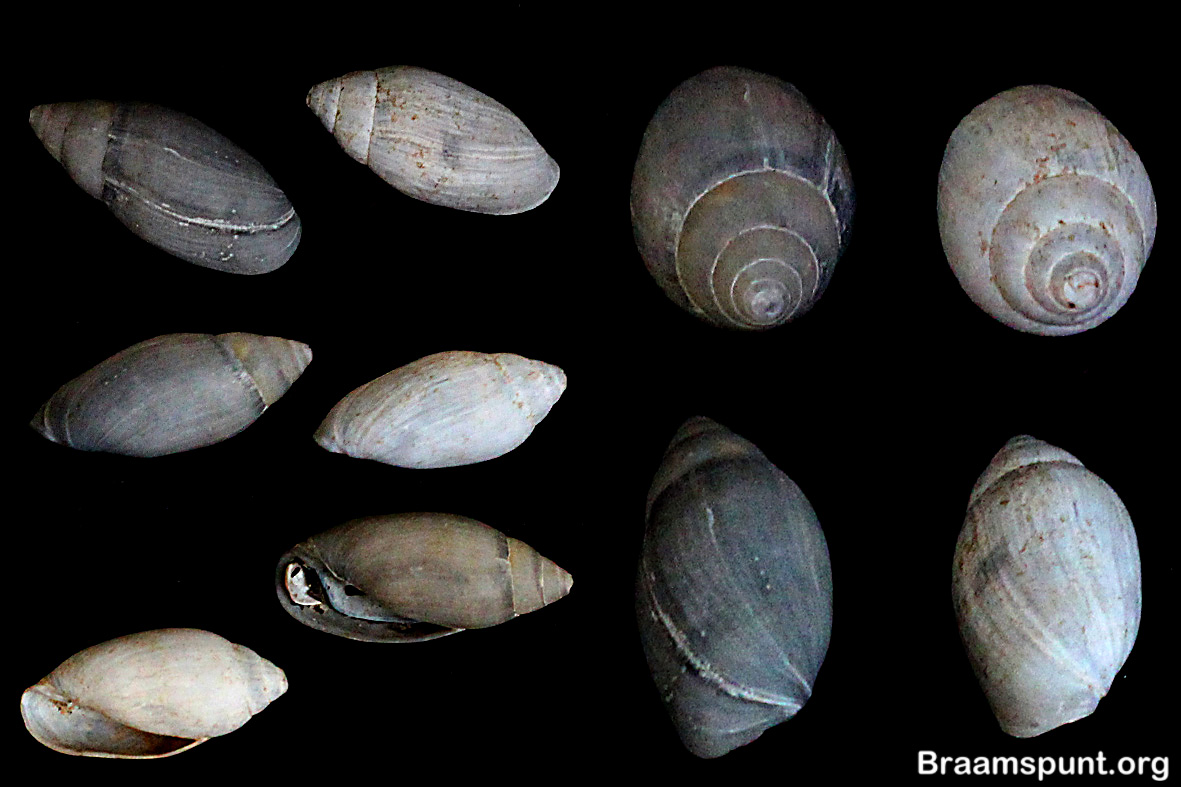 Resembles Marginella prunum but the shell is very much thinner and weaker. 5 whorled, smooth, white or grey in color and up to 3.75 cm in length. The body whorl is again large but the spire is better developed than in Marginella prunum. Outer lip of columella is not thickened (cf. Marginella prunum). The columella bears only 2 plicae.
Resembles Marginella prunum but the shell is very much thinner and weaker. 5 whorled, smooth, white or grey in color and up to 3.75 cm in length. The body whorl is again large but the spire is better developed than in Marginella prunum. Outer lip of columella is not thickened (cf. Marginella prunum). The columella bears only 2 plicae.
